Algae Guide
This algae guide is mainly aimed at the high
light tank being dosed by Estimative Index.
(But is applicable to any Carbon enriched tank)
| Black Brush Algae, BBA |
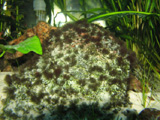
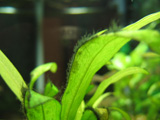
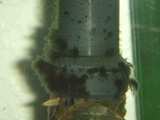
|
| Description |
Often grows on leaf edges of slow growing
plants, bog wood and mechanical equipment. Also sometimes it
grows in fast flowing areas of the tank. Grows in clumps or
patches of fine black tufts up to about 0.5cm long. |
| Cause |
In a high light tank it is an indication of
low or fluctuating CO2 levels or not enough water circulation
around the plants. In a low light tank it is often due to
changing CO2 levels. |
| Removal |
In a high light tank you will need to increase
your levels of CO2 and/or improve water circulation around the
plants. Scrub and cut off as much as you can first. Increase
levels slowly to 30ppm or more but watch the fish to see if they
are respiring heavily. Make sure you have good water flow around
the whole tank along with some good surface movement. Adding a
powerhead may help.
If you have a low light tank without CO2 injection then not
doing any water changes will help. This is because tap water
often has lots of CO2 dissolved in it which causes CO2 levels in
your tank to fluctuate. The algae respond to this a lot quicker
than the plants do.
Siamese Algae Eaters are known to eat BBA so can be used to
control this algae.
Overdosing Flourish Excel, EasyCarbo or TNC Carbon will clear it
up. |
| Blue Green Algae, BGA |
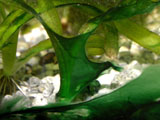
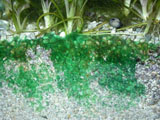
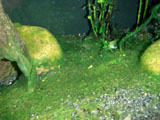
|
| Description |
This isn't a true algae, but a bacteria called
cyanobacteria that is able to photosynthesise. Covers everything
in a blue/green slimy mat. Easily peels off but grows back again
very quickly. It can smell pretty foul. It is very commonly
found in the substrate and especially along the front glass
where is receives light. |
| Cause |
Often caused by very low nitrates. It is
fairly common to have it growing in the substrate against the
front glass from where it can spread. Sometimes it appears with
new setups that have had light and ammonia present at some
point. Dirty substrates and filters may also bring it on. Poor
water circulation is another possible cause. |
| Removal |
A blackout is the best method for this. Clean
out as much of the algae as you can and do a 30 to 50% water
change. If your nitrates are low then add some potassium nitrate
to get levels to 20ppm. Remove CO2 and add an airstone. Turn off
lights and cover the whole tank so no light can enter. Leave it
for 3 to 4 days. No peeking and no feeding - fish will be fine
without food for this period. After 3 to 4 days remove the
covers and do a 30 - 50% water change. Remove airstone and start
CO2. You will need to dose nitrates to keep them dropping too
low again. Make sure your substrate and filter doesn't become
too clogged up with mulm and also make sure you have good water
circulation around the whole tank.
Another option is to treat with Maracyn which is an anti-biotic.
Seems to work well but may affect the biological filter. In the
UK it is illegal to purchase Maracyn without first getting a
prescription for it from a vet.
If the BGA is originating from the substrate place some dark
tape on the glass to hide the substrate from direct light. |
| Cladophora, Blanket Weed |
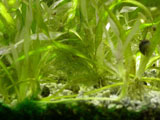 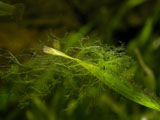 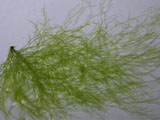 |
| Description |
Cladophora is a branching, green filamentous
algae. Feels a bit rough and sometimes a bit gritty. |
| Cause |
Low CO2. Low nutrient levels. |
| Removal |
Can be very stubborn and difficult to
eradicate. Make sure your dosing is good and keep your CO2
levels high. Manually pull out every bit you can see until it
stops growing. May take a while but should work eventually. Make
sure water circulation is good. Overdosing Flourish Excel,
EasyCarbo or TNC Carbon may clear it. Amano shrimp sometimes eat
it. |
| Diatoms, Brown Algae |
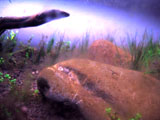 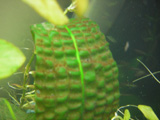 |
| Description |
Forms in brown patches on the glass, substrate
and plants. |
| Cause |
Usually found in newly setup tanks due to
silicates and ammonia as the filter and substrate have yet to
mature. |
| Removal |
Can be vacuumed out or wiped of the glass with
a soft cloth. Usually disappears after a few weeks when the tank
has matured. Otocinclus will eat it. |
| Green Dust Algae, GDA |
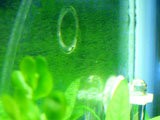
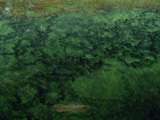
|
| Description |
Forms on the glass creating a dusty appearance
across the glass. Sometimes so bad you can't see into the tank. |
| Cause |
Low CO2. Low nutrients. Quite common on new
setups. |
| Removal |
Easily removed with a magnetic glass scraper
or similar. Often reappears very quickly. Allow the algae to run
its full cycle by leaving it well alone for 3 weeks. It may
become unsightly but just bear with it. Then scrape it all off
and do a large water change. Sometimes requires a second
treatment to fully clear and leaving it for 4 weeks. Recommended
to slightly reduce dosing during treatment. |
| Green Spot Algae, GSA |
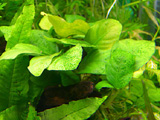
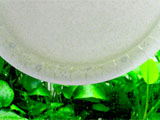
|
| Description |
Forms hard green circular spots on the glass
and slow growing plant leaves. |
| Cause |
With Estimative Index low phosphate levels
often bring on a GSA outbreak. Also Low CO2 and poor water flow.
Too long a lighting period doesn't help. |
| Removal |
If dosing Estimative Index increase phosphate
levels by adding monobasic potassium phosphate or fleet enema
solution. Aim for a level of 2 to 3ppm. Check CO2 levels and
water flow. Can be scraped off the glass using a razor blade or
a good magnetic glass scraper. Between 9 and 10 hours is plenty
of lighting time for the plants. If it is more then reducing it
may help.
If dosing a lean dosing method like PMDD or PPS-Pro then
modifying the NO3 to PO4 ratio normally helps. A bit of trial
and error may be required. |
| Green Water |
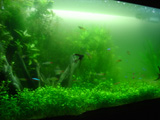 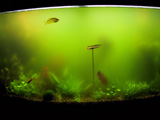 |
| Description |
This is a unicellular algae. Water goes
cloudy. Sometimes just a green tint, other times it can look
like pea soup. |
| Cause |
Ammonia is often the main cause green water.
There may have been an ammonia spike that isn't detected with
test kits. Other possible causes are an imbalance of nutrients
and/or low CO2 levels. |
| Removal |
Large water changes do not seem to always
help. If there is an imbalance in nutrients then fixing it will
sometimes make it go away by itself after a while. A three day
blackout followed by a large water change will hit it hard and
sometimes may clear it. A UV steriliser/clarifier or diatom
filter will clear it up very quickly and is often the only way
to clear it.
A new method is to use freshly cut 1-2 year old willow branches
about 0.5-1cm in width. Place these in your tank vertically so
they go from the substrate to a few centimetres above the
water's surface. After a few days they will start to grow roots
and the green water should start to clear. When cleared remove
the branches from the water.
Don't confuse this with a bacterial bloom which gives the water
a white haze. |
| Hair, Thread, Fuzz, etc |
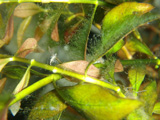
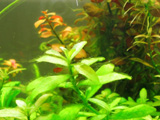
|
| Description |
These are very general names for a wide
variety of filamentous algae. Generally green and varying in
length. I have listed some of the more popular filamentous algae
under their own section on this page. |
| Cause |
A range of causes including low CO2, low
nutrient levels and ammonia spikes. Nothing to do with excess
iron as commonly thought. |
| Removal |
Can be very difficult to eradicate at times. A
high plant mass with good CO2 and a good supply of nutrients
along with constantly hassling the algae seems to pay off after
a while. Removal by twisting around a toothbrush or similar.
Overdosing Flourish Excel, EasyCarbo or TNC Carbon can help.
Amano shrimps, Rosy barbs and mollies will often eat it. |
| Oedogonium |
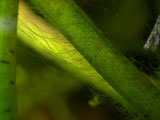 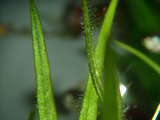 |
| Description |
A fairly short length filamentous algae that
can give a fuzz look to plants. |
| Cause |
Low CO2. Low nutrients. |
| Removal |
Check CO2 levels. Add nutrients. Overdosing
Flourish Excel, EasyCarbo or TNC Carbon can help. Amano shrimps,
Rosy barbs and mollies will often eat it. |
| Rhizoclonium |
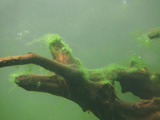
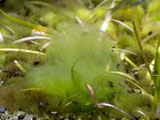
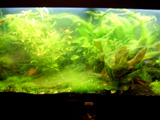 |
| Description |
Strands of fine green or brownish threads
which are soft and slimy. |
| Cause |
Low CO2 and poor water flow. Low nutrient
levels. General lack of maintenance. |
| Removal |
Increase CO2 levels and check nutrient dosing.
Give the tank a good cleaning. Overdosing Excel, EasyCarbo or
TNC Carbon should also clear it. Amano shrimp will eat it. |
| Spirogyra |
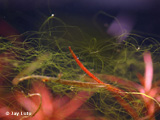 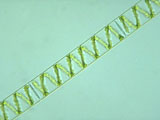 |
| Description |
Fine strands of green algae sometimes very
long in length. Slimy to the touch. Under a microscope the
chloroplasts are aligned in a spiral - hence the name. |
| Cause |
Often appears a couple of weeks after a
disturbance that causes a spike in ammonia. This can be anything
from a disturbance of the substrate to a dead fish gone
unnoticed. Likes high light levels and high nutrient levels. |
| Removal |
Once it has appeared it can be very hard to
clear as it thrives in the same conditions as plants. Pick out
as much as possible and do a three day blackout with CO2 turned
off and doing large daily water changes. Dose back with macros
after the water change. Afterwards I found normal dosing Excel
also helped, you could use EasyCarbo or TNC Carbon also. Rosy
barbs will eat it if made hungry. Also try reducing the
lighting.
Another method to try is to try lean dosing at around 1/4 to 1/8
Estimative Index levels for a few weeks. I had good success
doing this. |
| Staghorn |
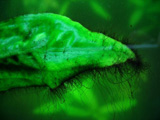 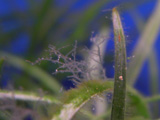 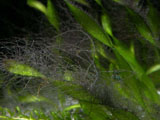 |
| Description |
Grows in strands that branches out. Looks a
bit like deer antler. Black to grey/green in colour and
sometimes has a red tint. |
| Cause |
Low CO2 and/or poor water circulation. A tank
with overfed fish and accumulated mulm. Dirty filter. Also
disturbing dirty substrates without doing water change
afterwards. |
| Removal |
Check CO2 levels and make sure you have good
water circulation. Reduce feeding, vacuum the substrate and
remove mulm. Overdosing Flourish Excel, EasyCarbo or TNC Carbon
usually helps. |
|
Notes
Insufficient, fluctuating or poor distribution of CO2 are
nearly always at the root of algae issues in high light
planted tanks, but measuring it can often be problematic and
misleading. There are 3 common methods used for calculating
CO2 levels.
|
|
The most common method for measuring CO2 is
by using the KH/pH tables. These can give false results
especially if you have any wood in your tank. The results will
tend to suggest that you have higher levels of CO2 than actual
levels. This is why you often see people having in excess of
100ppm CO2.
The one ph drop method involves leaving a cup
of tank water standing for 24 hours. If the pH of the tank
water is one point lower than the water in the cup then it is
said you have 30ppm CO2. This does presume that you have 3ppm
CO2 in the cup of tank water which very rarely is the case.
The drop checker method uses a drop checker
with a KH4 reference solution and a couple of drops of bromo
blue pH solution. When the colour is green, CO2 is good, blue
too low and yellow is too high. I like this method and use it
as an early warning system on my tank, but it does require
getting used to the colour changes.
|
|
If your CO2 is turned
off at night then turn it on about 2 hours before lights on. You
want CO2 levels to be at optimum levels when the lights are
turned on. Check levels to make sure that they are good and
compare morning to evening figures. You need to have stable CO2
levels through the whole of the lighting period.
Also of high importance to help prevent algae is having a good
flow of water around the whole tank. As a guide try to aim for
10x or more the rated filter flow rate to tank size. The idea of
this is to provide a constant supply of CO2 and nutrients to the
plants by having them move across the leave's surfaces. If you
can see all you plants gently swaying then your flow should be
good.
Seachem Flourish Excel, Easylife EasyCarbo and TNC
Carbon from The Nutrient Company can be used to fight
algae issues and they do seem to work very well against
certain types. You can either dose as instructions or two to
three times overdose for about two weeks to hit the algae
hard. They mainly kill BBA, but also can have an effect on
cladophora, staghorn and hair algae. They do affect some
plants though. The ones I'm aware of are Egeria Densa, Riccia,
Vallis and Fissidens. Some people also report it affecting
shrimp and ottos. Another trick is to mix 1 part
Excel/EasyCarbo/TNC Carbon to 3 parts water and add to a
sprayer. Do a large water change and whilst the water level is
low spray the exposed algae. Leave for 5 to 10 minutes and
then fill up with water.
|
This page was last updated by webmaster
- 05th February 2015






























